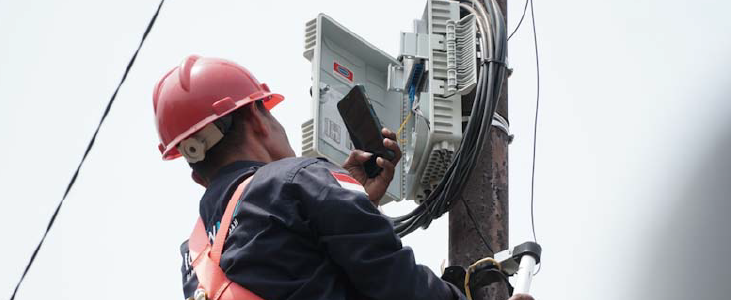Bitesize Fiber: Network construction | Episode 3: Building without the bottlenecks.
Welcome to Bitesize Fiber, the podcast where we explore the real world challenges and smart solutions shaping the future of fiber and telecom, one bite at a time.
In episode 3 of Bitesize Fiber: Network construction series, host Elli Puls is joined by Greg Ross and Stefan Schneider to tackle one of the biggest challenges in network builds—materials. From smart planning to real-time approvals, they explore how to keep construction moving without delays.
Bitesize Fiber: Network construction | Episode 3 transcript
Ellie Puls:
Welcome back to Bitesize Fiber, the podcast where we break down the toughest challenges in telecom and fiber, one bite at a time. I'm your host, Ellie Puls, and in this episode of our Network Construction Management series, we're talking about one of the biggest moving targets in any network build. Materials.
I'm joined again by Greg Ross and Stefan Schneider, and we're digging into how to plan, track and adapt material usage without holding up construction. From ordering based on high level design to managing change orders and getting approvals in real time, this conversation is all about avoiding delays and keeping your build on track. Let's get started.

|

|

|
| Ellie Puls, Product Manager | Greg Ross, Customer Success Manager | Stefan Schneider, Product Manager |
Ellie Puls:
What's the process of tracking materials, progress, any kind of changes, and how does that affect the timelines and budgets?
Greg Ross:
There's a feature that's in IQGeo obviously you can print out a BOM, a Bill of Materials. So, the project that I was on which was a very large project, we were able to actually order the materials based on the high level design. We would take Network Manager, we would run an automated scenario of a particular wire center and that would enable us to have a high level design. Well, the build that I was on particularly, they had a certain time frame in order to get the job done.
They were under the gun by their investors as everybody that wants to deploy nowadays seems to want to do it really fast, so, we found out that we were able to order the material at the high level design point, and then we would conduct walkouts to verify all the structures in the field. Then we were able to complete the low level design off of that. Meanwhile, while we were doing the walkout and we were doing the low level design completion, they ordered the material and materials can take, you know, thirty to forty-five days.
With the ability to order the material at HLD instead of LLD, it saved the vendor a lot of time and downtime of construction because the material was normally there either on time for the construction phase of that, or just a little bit after the construction due date of starting the project for that area. With the ability to have a high level design and complete your BOM and your material ordering in between the low level design is a very, very good factor. And we come to find out that there was less than a 5% difference of the material that was required on the low level design versus ordering it on the low level design, or doing it beforehand with the high level design. So, it really worked out to our benefit to do the material ordering at the HLD.
Ellie Puls:
That's super cool. Have you guys ever seen anything like this or is this kind of one of the first of its kind of this type of capability?
Greg Ross:
This is the first time that we've actually had a software that I've used to where you can keep it up to date, it's real mobile in the field, we didn't really have any issues with connectivity. I mean, as long as you have an LTE or a 5G connection in the field, and obviously if you're able to have a Wi-Fi, that's ideal. Most of the time when we were in the field and I personally tested that, I didn't really have a connection issue at all.
So, with that new capability of doing that, being able to see the approved permits in real time, and to have the permit approved to the permit polygon, it streamlines the permitting process because you can't complete construction without the permits. Like I said before, they go hand in hand. You need the most current construction drawing and you need the approved permit for that particular area. This was the first time that I had both of them readily available to me on a particular job.
Ellie Puls:
Stefan, what are some of the best practices for progress tracking, dealing with redlining and inventory?
Stefan Schneider:
So, if we were to think about best practices today in the digital age, there's a couple of things that pop up that are super important. One is you need to understand the work to be done so you can actually distribute and plan the work appropriately for this. One of the things that we have started to do inside the IQGeo ecosystem, is being much more flexible with automated ticket generation. If you're going to create work breakdown structures and tasks for contractors to follow, they're not just generic and they're actually adapted to the work that they're going to do and the kind of project that they're trying to do.
The second part is, as you start doing work and as you start finding changes because no design is going to be perfect and changes are going to happen in the field, it's being able to capture those things in the field, send them back for either overriding the design or have someone re-approved the design. Having that happen in minutes because you're sending the data back and someone can review it as opposed to days helps move the projects along a lot easier.
Then the key one is understanding your Bill of Materials and what you're supposed to do. When you have changes, being able to update your Bill of Materials and react to it. Being able to have your systems query your ERPs and get approvals faster. So you have this 360 view of financials and how to address them from the field instead of having to wait for someone, weeks or in some cases months to approve an extension for a build or for work to be done. Those are the key best practices that you can implement that we have been working really hard to support as part of our commitment to the industry.
Stay tuned for the next episode in our network construction series: AI without the overload. Meanwhile, catch up on the Bitesize Fiber series.
Ready to eliminate delays in your fiber network construction?
IQGeo helps telecom operators streamline every stage of the build process—from materials management to real-time approvals. Get in touch with our experts to see how our solutions can keep your project on track and under budget.
Similar articles:


 Previous
Previous







